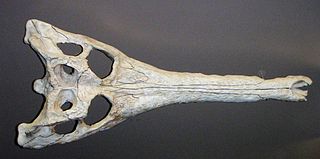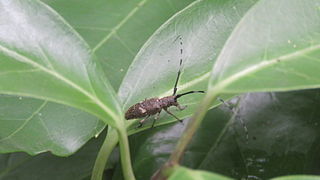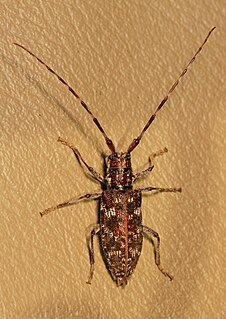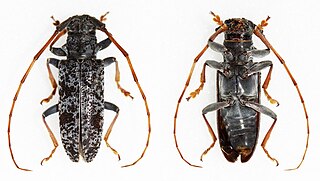
The white-breasted nuthatch is a small songbird of the nuthatch family common across much of temperate North America. It is stocky, with a large head, short tail, powerful bill, and strong feet. It has a black cap, white face, chest, and flanks, blue-gray upperparts, and a chestnut lower belly. Its nine subspecies differ mainly in the color of the body plumage.

The eastern gray squirrel, also known as the grey squirrel depending on region, is a tree squirrel in the genus Sciurus. It is native to eastern North America, where it is the most prodigious and ecologically essential natural forest regenerator. Widely introduced to certain places around the world, the eastern gray squirrel in Europe, in particular, is regarded as an invasive species.

Anolis carolinensis is an arboreal anole lizard native to the southeastern United States and introduced elsewhere. Common names include the Carolina anole,green anole, American green anole, American anole, and red-throated anole. It is also sometimes referred to as the American chameleon due to its ability to change color from several brown hues to bright green, however it is not a true chameleon.

The southern short-tailed shrew is a gray, short-tailed shrew that inhabits the eastern United States.

Chaos is a genus of single-celled amoeboid organisms in the family Amoebidae. The largest and best-known species, the so-called "giant amoeba" Chaos carolinense, can reach lengths of 5 mm, although most specimens fall between 1 and 3 mm.

The chuck-will's-widow is a nocturnal bird of the nightjar family Caprimulgidae. It is found in the southeastern United States near swamps, rocky uplands, and pine woods. It migrates to the West Indies, Central America, and northwestern South America.

Gastrophryne carolinensis, the eastern narrow-mouthed toad, is a species of microhylid frog. It is a relatively small, toad-like amphibian found in damp, shady habitats. The species is highly fossorial, and feeds primarily on ants. These North American microhylids are distinguished from true toads, and other anurans by their moist, smooth skin, their lack of eardrums or tympana, their distinguishable squat body shape, and the unique fold of skin superior to their eyes. It is found in the United States, from southern Maryland to the Florida Keys, west to Missouri and Texas. While not a true toad, it is so called because it is terrestrial.

Monochamus is a genus of longhorn beetles found throughout the world. They are commonly known as sawyer beetles or sawyers, as their larvae bore into dead or dying trees, especially conifers such as pines. They are the type genus of the Monochamini, a tribe in the huge long-horned beetle subfamily Lamiinae, but typically included in the Lamiini today.

Gavialosuchus is an extinct tomistomine from the early Miocene of Europe.

Monochamus scutellatus, commonly known as the white-spotted sawyer or spruce sawyer or spruce bug, is a common wood-boring beetle found throughout North America. It is a species native to North America.

Monochamus subfasciatus is a species of beetle in the family Cerambycidae. It was described by Henry Walter Bates in 1873. It is recorded from Japan where it infests Japanese red pine and is a vector of the nematode Bursaphelenchus doui.
Monochamus adamitus is a species of beetle in the family Cerambycidae. It was described by James Thomson in 1857. It is known from Tanzania, Sierra Leone, Angola, Ghana, Mozambique, the Ivory Coast, Senegal, the Democratic Republic of the Congo, Malawi, and Zimbabwe.

Monochamus sutor is a species of beetle in the family Cerambycidae. It was described by Carl Linnaeus in 1758, originally under the genus Cerambyx. It has a wide, natural distribution throughout Europe, and has also been introduced into Belgium and the Netherlands. Adults measure between 15 to 24 mm, and larvae measure up to 45 mm (1.8 in).

The spotted pine sawyer is a species of beetle in the family Cerambycidae. It was described by John Lawrence LeConte in 1852.

Monochamus galloprovincialis, the pine sawyer beetle, also referred to as the black pine sawyer beetle, is a species of beetle in the family Cerambycidae. It was described by Olivier in 1795, originally under the genus Cerambyx. It has a wide distribution, occurring naturally throughout Europe and the Caucasus. It has also been introduced into the Canary Islands. It serves as a vector for the parasitic nematode species Bursaphelenchus xylophilus, and also acts as a host to the parasitoid wasp species Dolichomitus tuberculatus.

Monochamus irrorator is a species of beetle in the family Cerambycidae. It was described by Chevrolat in 1855, originally apelled as "Monohammus" irrorator. It is known from the Republic of the Congo and Nigeria.
Monochamus leuconotus is a species of beetle in the family Cerambycidae. It was described by Francis Polkinghorne Pascoe in 1869, originally under the genus Anthores. It is known from Tanzania, Cameroon, Malawi, Kenya, Mozambique, Namibia, South Africa, Uganda, the Democratic Republic of the Congo, Zambia, Angola, and Zimbabwe. It feeds on Coffea arabica.
Monochamus ruspator is a species of beetle in the family Cerambycidae. It was described by Johan Christian Fabricius in 1781, originally under the genus Lamia. It has a wide distribution throughout Africa.

Monochamus sartor is a species of beetle in the family Cerambycidae. It was described by Johan Christian Fabricius in 1787, originally under the genus Lamia. It is known from throughout Europe, as well as in Kazakhstan, Mongolia, North Korea and South Korea. It is rated by the IUCN as Least Concern.
Monochamus thomsoni is a species of beetle in the family Cerambycidae. It was described by Chevrolat in 1855, originally under the genus Monohammus. It has a wide distribution throughout Africa. It contains the varietas Monochamus thomsoni var. buea.
















